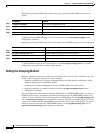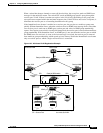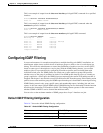
16-14
Catalyst 2950 Desktop Switch Software Configuration Guide
78-11380-05
Chapter 16 Configuring IGMP Snooping and MVR
Configuring MVR
MVR eliminates the need to duplicate television-channel multicast traffic for subscribers in each VLAN.
Multicast traffic for all channels is only sent around the VLAN trunk once—only on the multicast
VLAN. Although the IGMP leave and join message in the VLAN to which the subscriber port is
assigned. These messages dynamically register for streams of multicast traffic in the multicast VLAN
on the Layer 3 device. The access layer switch (S1 switch) modifies the forwarding behavior to allow
the traffic to be forwarded from the multicast VLAN to the subscriber port in a different VLAN,
selectively allowing traffic to cross between two VLANs.
IGMP reports are sent to the same MAC addresses as the multicast data. The S1 CPU must capture all
IGMP join and leave messages from receiver ports and forward them to the multicast VLAN of the
source (uplink) port.
Configuring MVR
These sections include basic MVR configuration information:
• Default MVR Configuration, page 16-14
• MVR Configuration Guidelines and Limitations, page 16-15
• Configuring MVR Global Parameters, page 16-15
• Configuring MVR Interfaces, page 16-16
Default MVR Configuration
Table 16-5 shows the default MVR configuration.
Table 16-5 Default MVR Configuration
Feature Default Setting
MVR Disabled globally and per interface
Multicast addresses None configured
Query response time 0.5 second
Multicast VLAN VLAN 1
Mode Compatible
Interface (per port) default Neither a receiver nor a source port
Immediate Leave Disabled on all ports


















